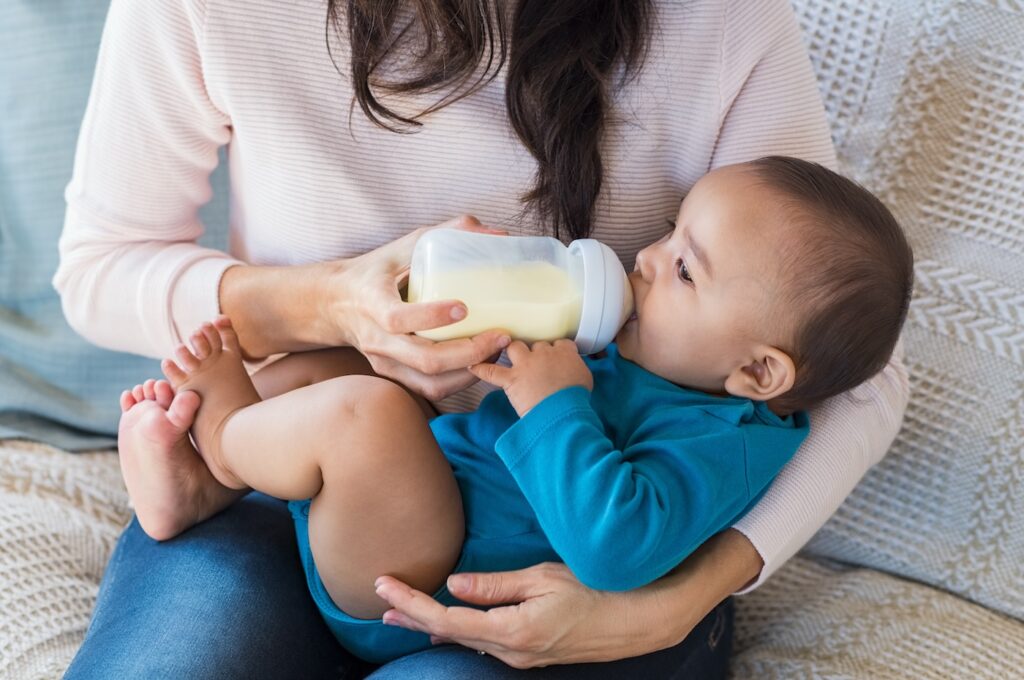The Modern Wet Nurse and Milk Sharing Today
Back before there was a breast versus bottle debate, women who could not or did not breastfeed were able to choose a third option: breast milk from another mother. This is known today as milk sharing. Here, Krista Cornish Scott shares her experience as a modern wet nurse by donating milk to her adopted nephew.

In most traditional cultures, this meant wet-nursing, with family members able to provide this often life-saving role.
In later periods such as 19th century England, the upper classes outsourced their childrearing and nursing. Cross-culturally, wet-nursing had a wide sense of approval as a beneficial gift to the community.
It was occasionally associated with taboos. In some Muslim communities, a child that had been wet-nursed could not then marry into that woman’s family, as they would be considered a sibling of the children who had breastfed from the same mother.
The Modern Wet Nurse is Now Called Cross-Nursing
With the advent of pumps, freezers, and milk bags came a new tradition of milk sharing that does not require wet-nursing in the traditional sense. Women who have an abundance of breastmilk can choose to share with others in need, in formal and informal ways.
The role is rarely called “wet nurse” today. Instead the process is referred to as cross-nursing.
The Human Milk Banking Association of North American (HMBANA) takes donations gladly; women undertake a screening process that includes a phone screening, blood testing, and they must have a minimum of 100 ounces to donate.
The donor milk is then pasteurized and processed for infants in need. HMBANA through its member banks have provided 3.2 million ounces of milk in the last year alone from more than 5,000 donor moms.
Direct Milk Sharing
Another growing trend is direct milk sharing. Mothers increasingly are going online to offer a surplus of their own milk, or to seek others’ milk for their babies. Many mothers connect in forums and social media groups to share and receive milk.
Organizations like Human Milk 4 Human Babies, started by Canadian mother Emma Kwasnica, support mother-to-mother connection outside of the official milk bank route. You might even find moms willing to share at your local breastfeeding support meeting.
This method is not without its critics, however, and some refer to the 2013 study published in the journal Pediatrics which found “Human milk purchased via the Internet exhibited high overall bacterial growth and frequent contamination with pathogenic bacteria, reflecting poor collection, storage, or shipping practices.” (source)
Alison Stuebe, Director of Lactation Service and OB at the University of Western Sydney addresses the difference between milk purchased over the internet, and peer-to-peer milk sharing. She points out that the methodology employed by the researchers was unlikely to mimic the actual conditions of true informal milk sharing, including the more likely scenario of local pick-up rather than packing and shipping.
The Personal Side of Milk Sharing
Krista’s interest in this topic is a personal one. When her youngest daughter was born, she began pumping and freezing first the precious colostrum and then breast milk. She carefully labeled and froze her milk to donate to her sister who was waiting to adopt a baby.
“When her son joined their family, I researched dry ice and overnight shipping options. Soon I was dropping off a large box to the post office, feeling nervous and elated that I was able to send the most meaningful new baby gift that I would ever have the privilege to give.”
Each little bag nestled into the container was truly liquid love, some carrying little messages like: “Butterfinger milk!” on the bag Krista pumped on Halloween night, or “Love you baby Alex.”
Her sister is a registered nurse and didn’t hesitate to receive her sister’s breast milk. “It was a no-brainer for me that babies need breast milk for optimum health. I didn’t spend a minute worrying about the potential for disease because his milk was from my sister.”
Kerri was able to give Alex breast milk for seven months from a handful of close friend donors. She is still touched that women were willing to step forward to donate milk. “I loved giving Alex his bottle. It was our special time together, and I knew I was providing for him the most biologically appropriate food I could possibly find.”
Make a Safe Choice
Like all feeding choices, informal milk sharing carries both benefits but also an element of risk. Patty Jacobs, president of Breastfeeding USA, points out that the World Health Organization places donor breast milk above formula on their hierarchy of preferred options for infant feeding.
“As an evidenced based organization, we believe a mother should be given accurate information, weighing the pros and cons of casual milk sharing, using banked human milk, or using formula. Mothers faced with the need to supplement must decide for themselves what is best for their particular situation.”
Many precautions are taken from organizations like the Human Milk Banking Association of America. They state that women who wish to donate their breastmilk must be in good general health, willing to undergo a blood test, and not regularly use medications.
Potential donors must not have a positive blood test result for HIV, HTLV, hepatitis B/C or syphilis, use illegal drugs, smoke, or use tobacco products, have received an organ or blood transfusion in the last 12 months or regularly have more than two ounces of alcohol per day. (source)
More Breastfeeding Options and Advice
Herbs for Increasing Your Milk Supply
Low Milk Supply Causes and Myths
How to Choose a Breast Pump
Essential Breastfeeding Supplies
How Breastfeeding Is Good for You, Baby, and the Environment
Breastfeeding in Public is a Civil Right
This article was published in 2012 and updated in 2024.
